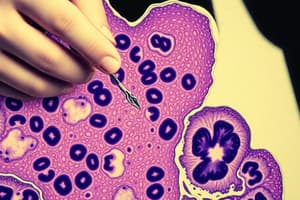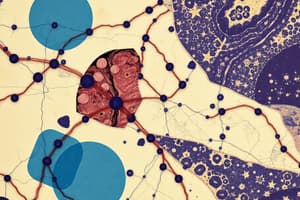Podcast
Questions and Answers
What color does PAS staining produce when it reacts with carbohydrates?
What color does PAS staining produce when it reacts with carbohydrates?
- Red color
- Magenta color (correct)
- Black color
- Blue color
What is the primary difference in magnification between light microscopes and electron microscopes?
What is the primary difference in magnification between light microscopes and electron microscopes?
- Electron microscopes can magnify up to 50000x. (correct)
- Electron microscopes can magnify to a maximum of 1000x.
- Light microscopes have a resolution power of about 1 nm.
- Light microscopes can magnify up to 50000x.
Which statement correctly describes the resolution power of light microscopes?
Which statement correctly describes the resolution power of light microscopes?
- The resolution is only effective for live specimens.
- It can differentiate particles as close as 0.2 μm apart. (correct)
- The resolution power is approximately 1 nm.
- It can differentiate particles as close as 50 nm apart.
What is the basis for the common staining methods utilized in histology?
What is the basis for the common staining methods utilized in histology?
Which microscopy technique allows for three-dimensional visualization of a specimen's surface?
Which microscopy technique allows for three-dimensional visualization of a specimen's surface?
What factor does NOT affect the magnification of a light microscope?
What factor does NOT affect the magnification of a light microscope?
How is the resolution power of an electron microscope different from that of a light microscope?
How is the resolution power of an electron microscope different from that of a light microscope?
What is the purpose of tissue fixation in microscopic procedures?
What is the purpose of tissue fixation in microscopic procedures?
Which of the following types of cells are most effectively visualized using electron microscopy?
Which of the following types of cells are most effectively visualized using electron microscopy?
What contributes to the higher resolution of electron microscopes over light microscopes?
What contributes to the higher resolution of electron microscopes over light microscopes?
Flashcards
Tissue Fixation
Tissue Fixation
Preserving tissues to maintain their original structure and prevent decay.
Tissue Embedding
Tissue Embedding
Process of encasing tissue in a solid medium for sectioning.
Hematoxylin and Eosin
Hematoxylin and Eosin
Common staining method used in light microscopy to stain tissues.
Light Microscope
Light Microscope
Signup and view all the flashcards
Electron Microscope
Electron Microscope
Signup and view all the flashcards
Resolution Power
Resolution Power
Signup and view all the flashcards
Scanning Electron Microscope
Scanning Electron Microscope
Signup and view all the flashcards
PAS Stain
PAS Stain
Signup and view all the flashcards
Magnification (Light Microscopy)
Magnification (Light Microscopy)
Signup and view all the flashcards
Cytochemical and Histochemical Techniques
Cytochemical and Histochemical Techniques
Signup and view all the flashcards
Study Notes
Introduction
- The presentation is about histology, specifically methods of staining tissue samples for microscopic analysis.
- The presenter is Dr. Dalia Eita.
- The institution is Mansoura National University.
Agenda
- Methods for preparing tissue samples for light microscopy
- Staining principles using Hematoxylin & Eosin
- Types of stains
- Types of microscopes
Learning Objectives
- Demonstrate tissue fixation and embedding procedures.
- Identify and explain common staining techniques.
- Explain the application of cytochemical and histochemical approaches.
- Compare light and electron microscopy.
Special Stains for Organic Components
- Carbohydrates:
- Periodic acid-Schiff (PAS) stain uses periodic acid to react with carbohydrates creating aldehyde groups, aldehyde group reacts with Schiff's reagent then turns magenta
- Best Carmine stain highlights glycogen, giving glycogen granules a red colour.
- Lipids:
- Frozen sections are used
- Sudan III stains lipids orange
- Sudan black stains lipids black
- Osmium tetroxide stains lipids black
Other Methods of Staining
- Vital stains: These stains are used to observe living cells e.g. staining of phagocytes (cells of the body's immune system) with Trypan blue or Indian ink.
- Metachromatic Stains: These stains show differences in color compared to that of the dye. An example is mast cell's granules which have a reddish-purple color when stained with toluidine blue.
- Enzyme Histochemistry: Frozen tissue sections are used to locate and study specific enzymes e.g alkaline phosphatase in kidney tubules.
Quiz (PAS stain)
- PAS stains carbohydrates and turns magenta.
Microscopy: Types of Microscopes
- Light microscopes: Used in educational settings, have magnifications of 40x, 100x, 400x, and 1000x.
- Electron microscopes: Higher magnification (up to 50,000x) and resolution allowing for observation of smaller structures compared to light microscope.
Resolution Power
- Resolution power measures the smallest distance between two particles that can be distinguished as separate particles.
- Light microscopes have a resolution power of about 0.2 micrometers (200 nanometers).
- Electron microscopes have a resolution power of around 1 nanometer.
Practical Class: How to Use a Microscope
- Step-by-step instructions on how to use a light microscope, are provided in the form of instructions in the presentation.
Micro Technique for Electron Microscopy
- Ultrathin sections (50-100 nm thick) are made using an ultramicrotome.
- Sections are stained using heavy metals (lead citrate and uranyl acetate)
- Dark components in electron micrographs are called electron-dense, while light components are called electron-lucent.
Scanning Electron Microscope (SEM)
- Allows for 3-dimensional visualization of the surface of a fixed specimen
Studying That Suits You
Use AI to generate personalized quizzes and flashcards to suit your learning preferences.





